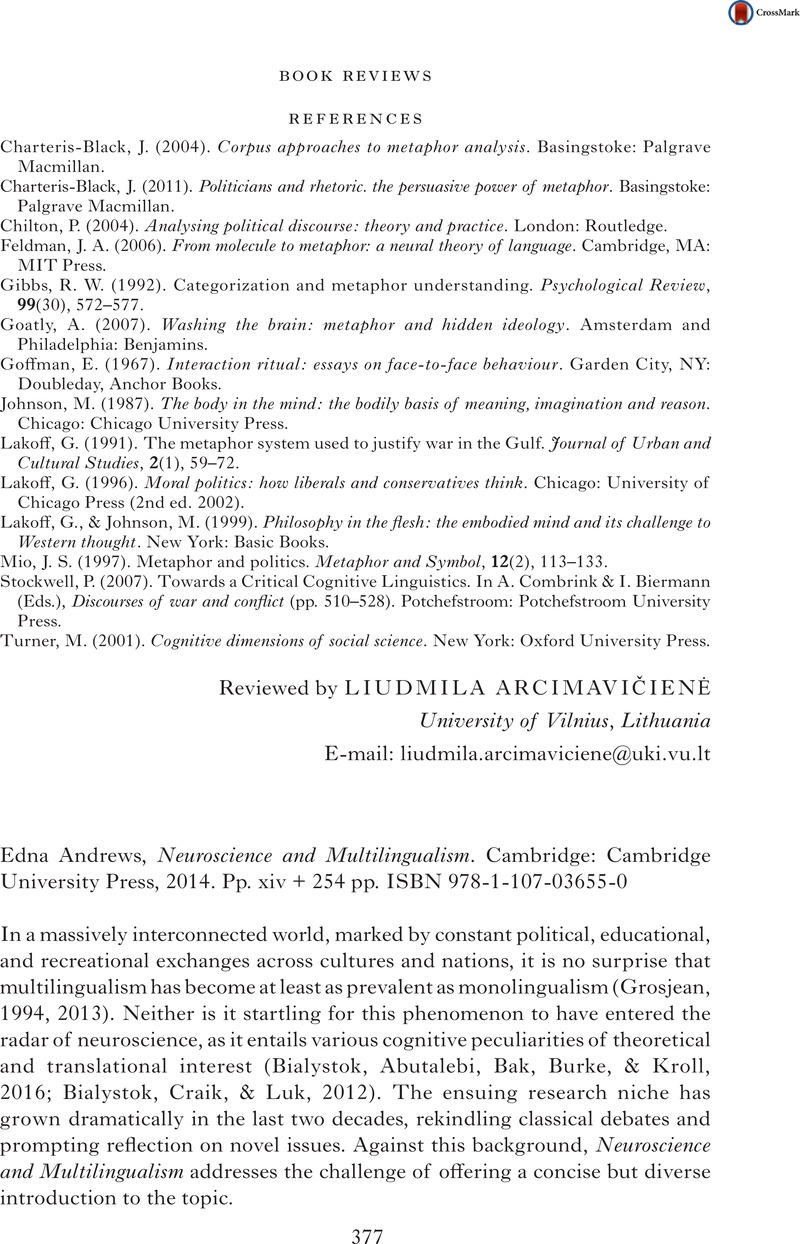No CrossRef data available.
Article contents
Edna Andrews, Neuroscience and Multilingualism. Cambridge: Cambridge University Press, 2014. Pp. xiv + 254 pp. ISBN 978-1-107-03655-0
Review products
Edna Andrews, Neuroscience and Multilingualism. Cambridge: Cambridge University Press, 2014. Pp. xiv + 254 pp. ISBN 978-1-107-03655-0
Published online by Cambridge University Press: 20 February 2017
Abstract
An abstract is not available for this content so a preview has been provided. Please use the Get access link above for information on how to access this content.

- Type
- Book Reviews
- Information
- Copyright
- Copyright © UK Cognitive Linguistics Association 2017
References
references
Bialystok, E., Abutalebi, J., Bak, T. H., Burke, D. M., & Kroll, J. F. (2016). Aging in two languages: implications for public health. Ageing Research Reviews, 27, 56–60.Google Scholar
Bialystok, E., Craik, F. I., & Luk, G. (2012). Bilingualism: consequences for mind and brain. Trends in Cognitive Sciences, 16(4), 240–250.Google Scholar
Caffarra, S., Molinaro, N., Davidson, D., & Carreiras, M. (2015). Second language syntactic processing revealed through event-related potentials: an empirical review. Neuroscience & Biobehavioral Reviews, 51, 31–47.Google Scholar
Calvo, N., García, A. M., Manoiloff, L., & Ibáñez, A. (2015). Bilingualism and cognitive reserve: a critical overview and a plea for methodological innovations. Frontiers in Aging Neuroscience, 7, 249.Google Scholar
Ferré, P., Sánchez-Casas, R., & Guasch, M. (2006). Can a horse be a donkey? Semantic and form interference effects in translation recognition in early and late proficient and nonproficient Spanish–Catalan bilinguals. Language Learning, 56(4), 571–608.Google Scholar
García, A. M. (2015a). Translating with an injured brain: neurolinguistic aspects of translation as revealed by bilinguals with cerebral lesions. Meta: Translators’ Journal, 60(1), 112–134.Google Scholar
García, A. M. (2015b). Psycholinguistic explorations of lexical translation equivalents: thirty years of research and their implications for cognitive translatology. Translation Spaces, 4(1), 9–28.Google Scholar
Grosjean, F. (1994). Individual bilingualism. In Asher, R. E. (Ed.), The encyclopaedia of language and linguistics (pp. 1656–1660). Oxford: Pergamon Press.Google Scholar
Grosjean, F. (2013). Bilingualism: a short introduction. In Grosjean, F. and Li, P. (Eds.), The psycholinguistics of bilingualism (pp. 5–26). West Sussex: John Wiley & Sons Ltd.Google Scholar
Kroll, J. F., van Hell, J. G., Tokowicz, N., & Green, D. W. (2010). The Revised Hierarchical Model: a critical review and assessment. Bilingualism: Language and Cognition, 13, 373–381.Google Scholar
Moreno, E. M., Rodríguez-Fornells, A., & Laine, M. (2008). Event-related potentials (ERPs) in the study of bilingual language processing. Journal of Neurolinguistics, 21(6), 477–508.Google Scholar
Paap, K. R., Johnson, H. A., & Sawi, O. (2016). Should the search for bilingual advantages in executive functioning continue?
Cortex, 74, 305–314.Google Scholar
Paradis, M. (2004). A neurolinguistic theory of bilingualism. Amsterdam: John Benjamins.Google Scholar
Silverberg, S., & Samuel, A. G. (2004). The effect of age of second language acquisition on the representation and processing of second language words. Journal of Memory and Language, 51(3), 381–398.Google Scholar





